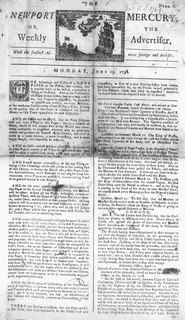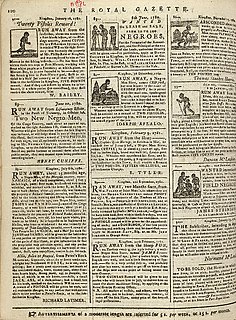John Holt (1721—1784) was a colonial American newspaper publisher, printer, postmaster, and mayor of Williamsburg, Virginia, United States. He was involved with publishing the Connecticut Gazette, the New York Gazette, and the New-York Journal newspapers. He worked with Benjamin Franklin, the prominent publisher James Parker, and Founding Father Samuel Adams. He had a store that sold miscellaneous supplies, ink, paper, and books on a variety of subjects including religion, freemasonry, economics, history, archaeology, poetry, and biographies.

The Boston News-Letter, first published on April 24, 1704, is regarded as the first continuously published newspaper in the colony of Massachusetts. It was heavily subsidized by the British government, with a limited circulation. All copies were approved by the Royal governor before publication. The colonies’ first newspaper was Publick Occurrences Both Forreign and Domestick, which published its first and only issue on September 25, 1690. The Weekly Jamaica Courant followed in Kingston, Jamaica from 1718. In 1726 the Boston Gazette began publishing with Bartholomew Green, Jr., as printer.
Kingston upon Hull, often simply referred to as Hull, was a parliamentary constituency in Yorkshire, electing two members of parliament to the House of Commons of the Parliament of the United Kingdom, from 1305 until 1885. Its MPs included the anti-slavery campaigner, William Wilberforce, and the poet Andrew Marvell.
The Maitland Mercury is Australia's third oldest regional newspaper, preceded only by the Geelong Advertiser and the Launceston Examiner . The Maitland Mercury was established in 1843 when it was called The Maitland Mercury and Hunter River General Advertiser. The Maitland Mercury is still in circulation serving the city of Maitland and the surrounding Lower Hunter Valley.
USS Herald was a full-rigged ship of about 270 tons burthen built at Newburyport, Massachusetts, possibly in 1797. The US Navy purchased her from Edward Davis on 15 June 1798, and sold her in 1801. She became the French 20-gun privateer corvette Africaine. In 1804 a British privateer seized her on 4 May 1804 off the coast, near Charleston, South Carolina. The seizure gave rise to a case in the U.S. courts that defined the limits of U.S. territorial waters. The U.S. courts ruled that the privateer had seized Africaine outside U.S. jurisdiction. Africaine then became a Liverpool-based slave ship that made two voyages carrying slaves from West Africa to the West Indies. After the abolition of the slave trade in 1807 she became a West Indiaman that two French privateers captured in late 1807 or early 1808.

TheNewport Mercury, was an early American colonial newspaper founded in 1758 by Ann Smith Franklin (1696-1763), and her son, James Franklin (1730–1762), the nephew of Benjamin Franklin. The newspaper was printed on a printing press imported by Franklin's father, James Franklin (1697–1735), in 1717 from London. The Mercury may be the first newspaper published by a woman in the colonial United States. The Mercury was the also first paper to publish poetry by an African American woman, Phillis Wheatley.
The following is a timeline of the history of the city of Kingston, Jamaica.
Otway was a French or Spanish vessel built in 1799 that became a Liverpool-based slaver in 1800. She made four voyages delivering slaves from West Africa to the West Indies before the French Navy captured her in 1806. She became the Guadeloupe-based privateer Alerte and captured a number of British merchantmen before the Royal Navy captured her i October 1807.
In Colonial Jamaica, during the 18th and 19th centuries, there were a number of newspapers that represented the views of the white planters who owned slaves. These newspapers included the Royal Gazette, The Diary and Kingston Daily Advertiser, Cornwall Chronicle, Cornwall Gazette, and Jamaica Courant. These newspapers often served parochial interests. The Diary and Kingston Advertiser served white residents in the city of Kingston and surrounding areas, while the Cornwall Chronicle and Cornwall Gazette catered to white planters and merchants in Montego Bay and surrounding areas. In 1826, two free coloureds, Edward Jordan and Robert Osborn, founded The Watchman, which openly campaigned for the rights of free coloureds, and became Jamaica's first anti-slavery newspaper. In 1830, Jamaican colonial authorities arrested Jordan, the editor, and charged him with constructive t. However, Jordan was eventually acquitted, and became Mayor of Kingston in post-Emancipation Jamaica.

Alexander Aikman was a Scottish printer, newspaper publisher, planter, and member of Jamaica's House of Assembly. From 1805 to 1825, he was a member of the House of Assembly as the representative of Saint George parish.
Louisa Wells Aikman, also known as Louisa Susannah Aikman, was a British author and music score collector. She is best known for her book, The journal of a voyage from Charleston, S.C., to London.
HMS Otter was the French merchantman Glanure, which the Royal Navy (RN) captured early in 1778. The Royal Navy took her into service as the sloop HMS Otter and she served in the American theatre. The Navy sold her in 1783. She became a merchantman and then a slave ship. She made two complete voyages bringing slaves to Jamaica. The French captured her in December 1795 as she was on her way to deliver her third cargo of slaves.

The Honduras Gazette, published as The Honduras Gazette and Commercial Advertiser, was the first newspaper and government gazette in colonial Belize. It ran from 1 July 1826 until sometime during 1829–1838, being succeeded on 29 September 1838 by the Belize Advertiser.

The Weekly Jamaica Courant, published as The Weekly Jamaica Courant, with News Foreign and Domestick, was the first newspaper published in colonial Jamaica and the West Indies, and the second regular newspaper in the British settlements of the New World. It was first published in 1718, and was disestablished in 1755, being succeeded or replaced by the Jamaica Gazette or the St. Jago de la Vega Gazette.





